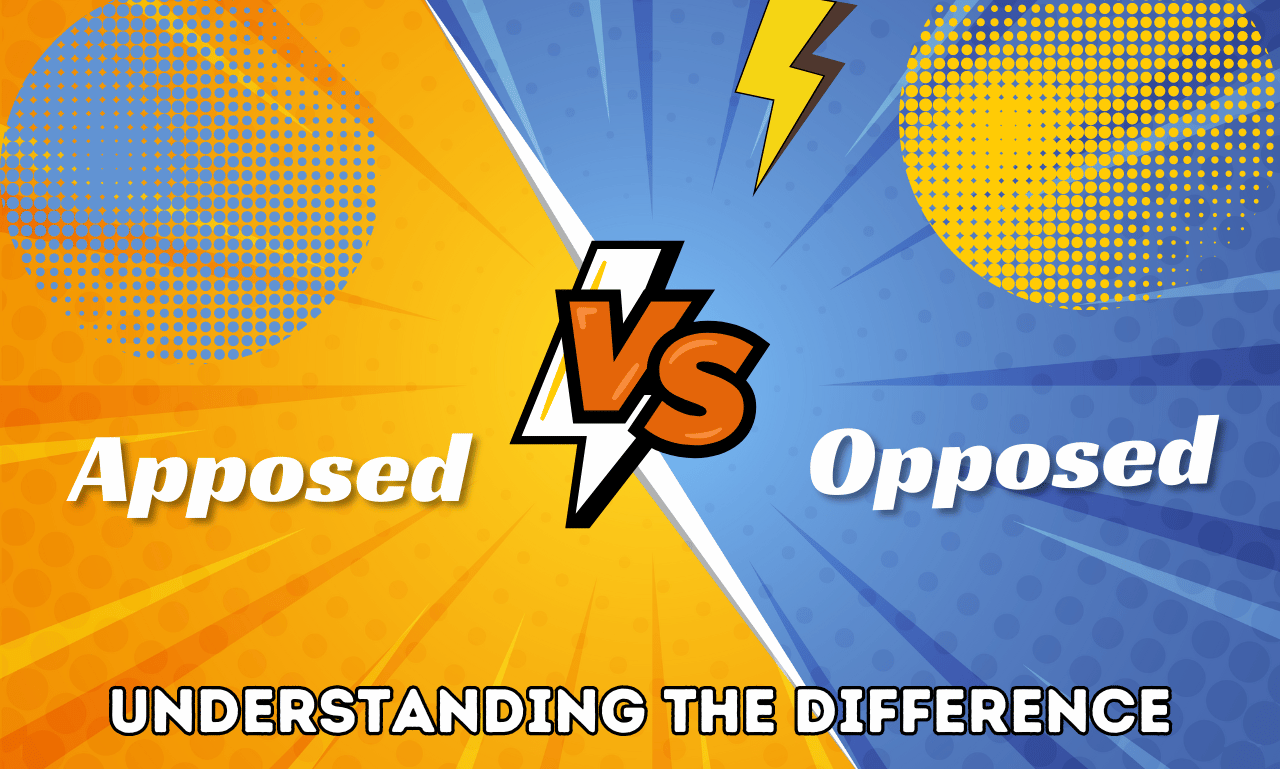Apposed vs. Opposed: Understanding the Difference
Apposed and opposed are two frequently used words in English, often employed to describe contrasting concepts or positions. Understanding the subtle differences between their meanings is essential for effective communication.
Definition:
- Apposed: Placed side by side or close together.
- Opposed: Located opposite each other or having opposing characteristics.
Usage:
Apposed is typically used in a physical or spatial sense to describe objects or elements positioned close together or adjacent to each other.
Opposed is used broadly to describe contrary, conflicting, or in contrast. It can refer to physical positions, ideas, opinions, or actions.
Examples:
Apposed:
- The two buildings were opposed to each other on the street corner.
- The leaves were apposed on the stem.
- The magnets were apposed with their opposite poles facing each other.
Opposed:
- The two teams were opposed to each other in the championship game.
- The candidate’s views were opposed to the majority opinion.
- The wind was opposed to the direction of the plane’s flight.
Key Differences between Apposed and Opposed:
1. Meaning:
- Apposed: Placed or situated side by side, often in a contrasting or parallel manner.
- Opposed: Situated or acting in opposition to something else.
2. Implication:
- Apposed: Proximity, juxtaposition, or comparison.
- Opposed: Conflict, disagreement, or resistance.
3. Usage:
- Apposed: Describing physical arrangements or comparisons.
- Opposed: Expressing disagreement, conflict, or resistance.
4. Context:
- Apposed: Focuses on physical placement or comparison.
- Opposed: Emphasizes conflict or disagreement.
Remember:
- “Apposed” is used when discussing things that are placed side by side, while “opposed” is used when discussing things in conflict or disagreement.
- Consider the context of your sentence to determine which word is more appropriate.
Examples:
- The two paintings were apposed on the wall, inviting viewers to compare their styles.
- The politician opposed the new tax proposal, citing its potential negative economic impact.
Usage Tips for Apposed vs. Opposed:
Apposed:
- Use “apposed” when describing things placed side by side, often for comparison or contrast.
- It implies proximity or juxtaposition without necessarily indicating opposition.
- Example: “The two paintings were apposed on the wall, inviting viewers to compare their styles.”
Opposed:
- Use “opposed” when describing things in direct conflict or disagreement.
- It implies resistance, disapproval, or a clash of opinions.
- Example: “The politician was strongly opposed to the new tax proposal, citing its potential negative impact on the economy.”
Additional Tips:
- Remember that “apposed” focuses on physical placement or comparison, while “opposed” emphasizes conflict or disagreement.
- Consider the context of your sentence to determine which word is more appropriate.
- If you’re describing a physical arrangement or comparison, use “apposed.”
- If you’re conveying opposition or resistance, use “opposed.”
- Proofread your writing carefully to ensure you’re using these words correctly.
Summary Table:
| Word | Definition | Usage | Example |
| Apposed | Placed or situated side by side | Describing things that are adjacent or in a contrasting/parallel manner | “The two houses were opposed to each other, their architectural styles contrasting sharply.” |
| Opposed | Situated or acting in opposition to something else | Expressing disagreement, conflict, or resistance | “The environmental group was strongly opposed to the proposed development, citing its potential harm to the local ecosystem.” |
Key Difference:
- Emphasizes physical placement or comparison, while opposed emphasizes conflict or disagreement.
Remember to consider the context of your sentence and the intended meaning when choosing between “apposed” and “opposed.”
Read More: Clark County Education Association: Advocating for Educators and Students
How Good Is Our Early Learning and Childcare?
Conclusion:
Apposed and opposed are two distinct words that are often confused due to their similar spelling and pronunciation. However, their meanings are quite different. Opposed refers to things placed side by side, while opposed refers to things in conflict or disagreement. Understanding the subtle differences between these words and using them correctly in your writing and speech is essential. When in doubt, consider the context of your sentence and the intended meaning you want to convey. By using opposed and opposed appropriately, you can enhance the clarity and precision of your communication.
FAQ (Frequently Asked Questions) on Apposed vs. Opposed
1. What is the main difference between opposed and opposed?
Apposed means placed side by side, while opposed means in conflict or disagreement.
2. When should I use opposed?
Use apposed when describing things adjacent to each other or in a contrasting/parallel manner.
3. When should I use opposed?
Use opposed when expressing disagreement, conflict, or resistance.
4. Can opposed and opposed ever be used interchangeably?
No, they should not be used interchangeably as they have different meanings.
5. What are some examples of how to use opposed and opposed correctly?
- Apposed: “The two chairs were apposed to each other, creating a cozy seating area.”
- Opposed: “The environmental group was strongly opposed to the proposed development.”
6. Is it grammatically correct to say “apposed to”?
Yes, “apposed to” is grammatically correct when expressing opposition or disagreement.
7. What is the opposite of opposed?
The opposite of opposed is “separated” or “detached.”
8. What is the opposite of opposed?
The opposite of opposed is “supportive” or “in agreement.”
Remember, the key to using apposed and opposed correctly lies in understanding their distinct meanings and applying them appropriately in context.


